ElasticSearch 全文检索
ElasticSearch 全文检索
ElasticSearch

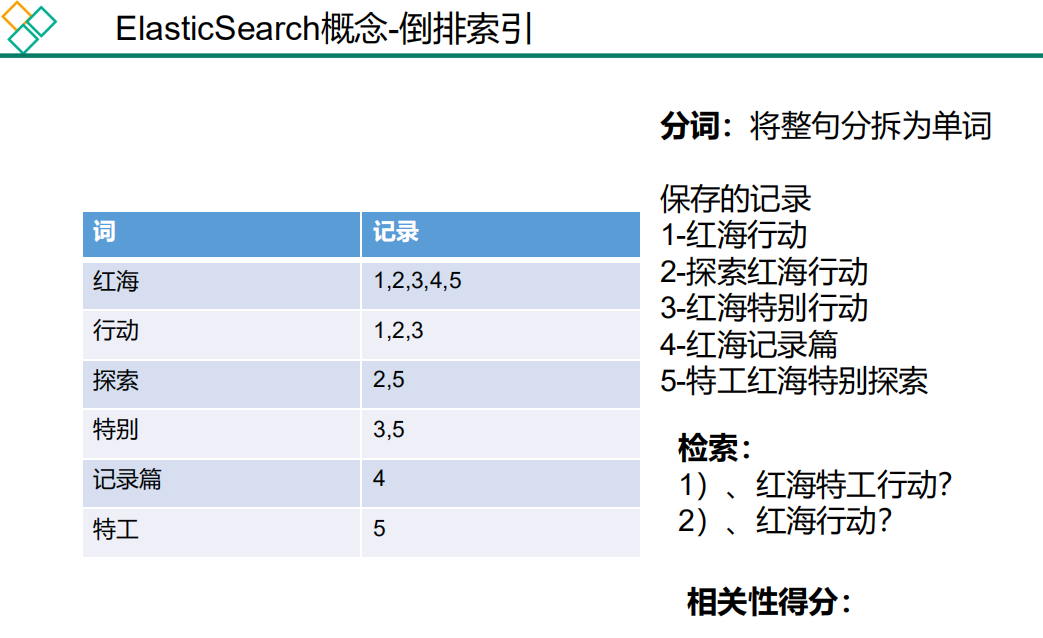
1. ElasticSearch概念
1.1 ES介绍
应用程序搜索 网站搜索 企业搜索 日志处理和分析
基础设施指标和容器监测 应用程序性能监测
地理空间数据分析和可视化 安全分析 业务分析
官方文档 : https://www.elastic.co/guide/en/elasticsearch/reference/current/index.html
官方中文 : https://www.elastic.co/guide/cn/elasticsearch/guide/current/foreword_id.html
社区中文: https://es.xiaoleilu.com/index.html、http://doc.codingdict.com/elasticsearch/0/
1.2 基本概念
Elasticsearch也是基于Lucene的全文检索库,本质也是存储数据,很多概念与MySQL类似的。
对比关系:
索引(indices)----------------------Databases 数据库
类型(type)--------------------------Table 数据表
文档(Document)----------------------Row 行
字段(Field)-------------------------Columns 列
index:索引
type: 数据类型
document
保存 在 某 个 索引 (Index) 下 , 某 种 类 型 Type) 的 一 个 数据 (Document) , 文 档 是 JSON 格
式 的 ,Document 就 像 是 MySQL 中 的 某 个 Table 里 面 的 内 容
要注意的是:Elasticsearch本身就是分布式的,因此即便你只有一个节点,Elasticsearch默认也会对你的数据进行分片和副本操作,
当你向集群添加新数据时,数据也会在新加入的节点中进行平衡。
2 安装
docker pull elasticsearch:7.14.0 存储和检索数据
docker pull kibana:7.14.0 可视化数据
查看 elasticsearch
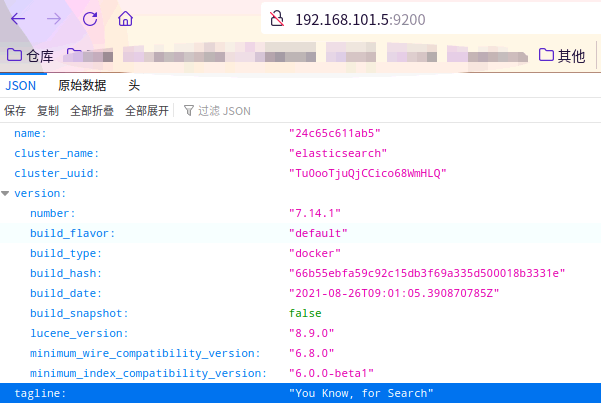
查看 kibana
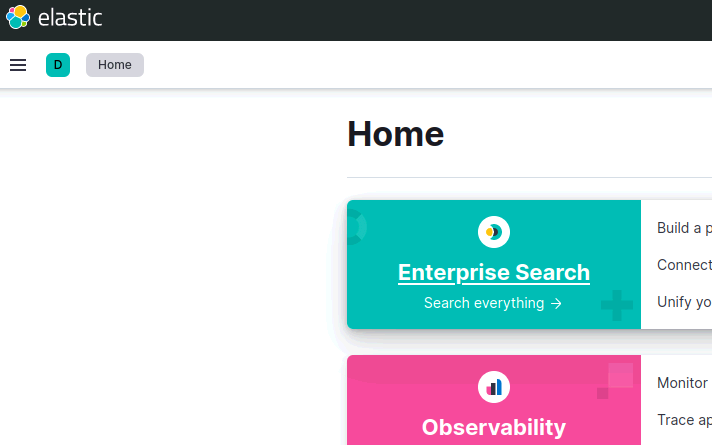
3 索引操作(indices)
3.1 查询索引
/_cat/indices?v 有哪些索引库
/_cat/nodes 查看节点信息
/_cat/health 查看es健康状态
/_cat/master 查看主节点
/_cat/indices 查看所有索引
es 中会默认存在一个名为.kibana和.kibana_task_manager的索引
表头的含义
| 字段名 | 含义说明 |
|---|---|
| health | green(集群完整) yellow(单点正常、集群不完整) red(单点不正常) |
| status | 是否能使用 |
| index | 索引名 |
| uuid | 索引统一编号 |
| pri | 主节点几个 |
| rep | 从节点几个 |
| docs.count | 文档数 |
| docs.deleted | 文档被删了多少 |
| store.size | 整体占空间大小 |
| pri.store.size | 主节点占 |
3.2 创建索引
保存: PUT /index/type/标识id
如: PUT /customer/demo/1
PUT 和 POST都可以.
POST 新增。如果不指定id,会自动生成id。指定id就会修改这个数据,并新增版本号
PUT 可以新增&修改。PUT必须指定id,由于PUT需要指定id,我们一般都用来做修改操作,不指定id会报错 。
响应结果
{
"_index": "customer", #索引
"_type": "demo", #类型
"_id": "1", #id
"_version": 5, #版本
"result": "updated", #状态
"_shards": {
"total": 2,
"successful": 1,
"failed": 0
},
"_seq_no": 5, #并发控制字段,每次更新就会+1,用来做乐观锁
"_primary_term": 1 #同上,主分片重新分配,如重启,就会变化
}
PUT
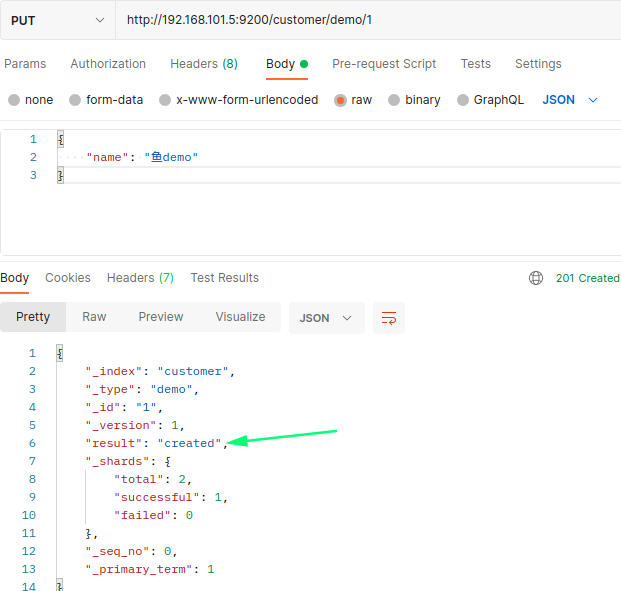
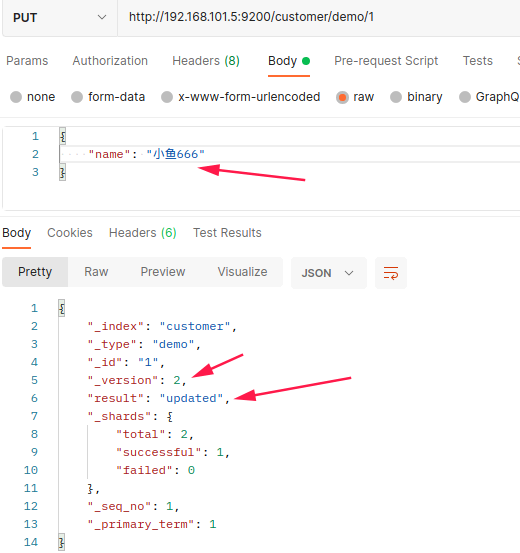
不指定ID报错
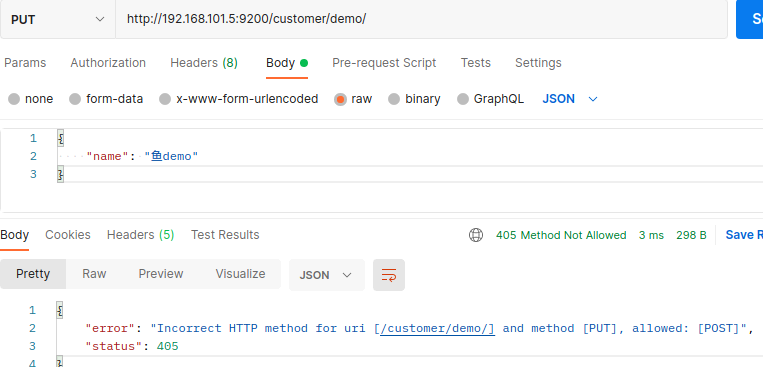
POST

3.3 get 查询文档&乐观锁
get http://192.168.100.5:9200/customer/demo/1
{
"_index": "customer",
"_type": "demo",
"_id": "1",
"_version": 8,
"_seq_no": 14,
"_primary_term": 1,
"found": true,
"_source": {
"name": "小鱼666"
}
}
更新携带 ?if_seq_no=14&if_primary_term=1
并发修改测试:多个人同时修改一个数据
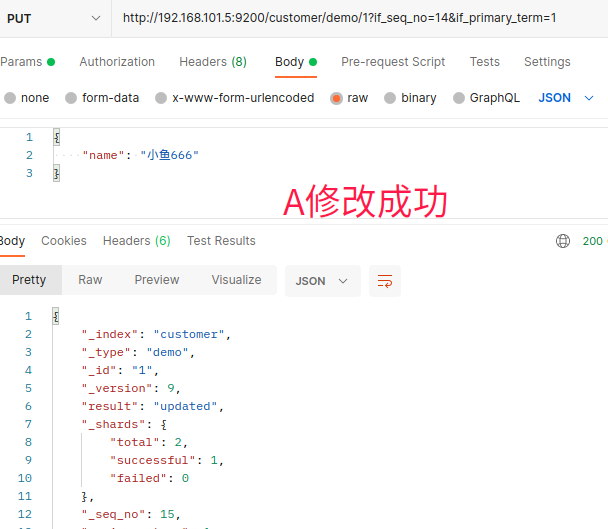
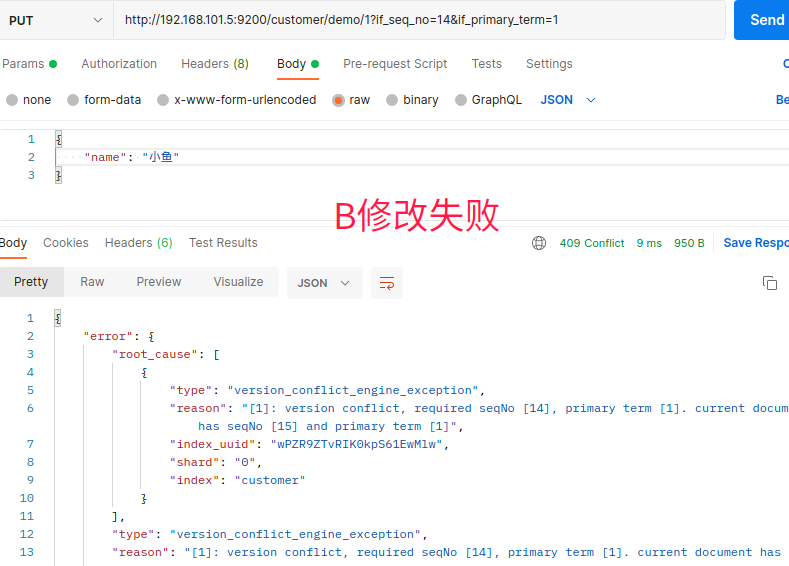
读取
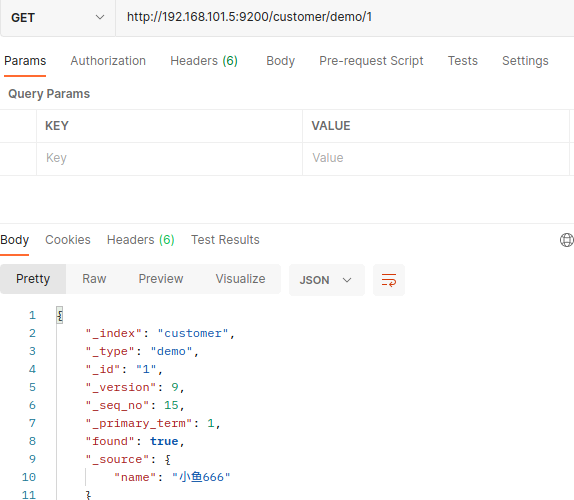
如果想要修改成功,就需要获取最新的_seq_no
3.4 post 更新文档
更新1
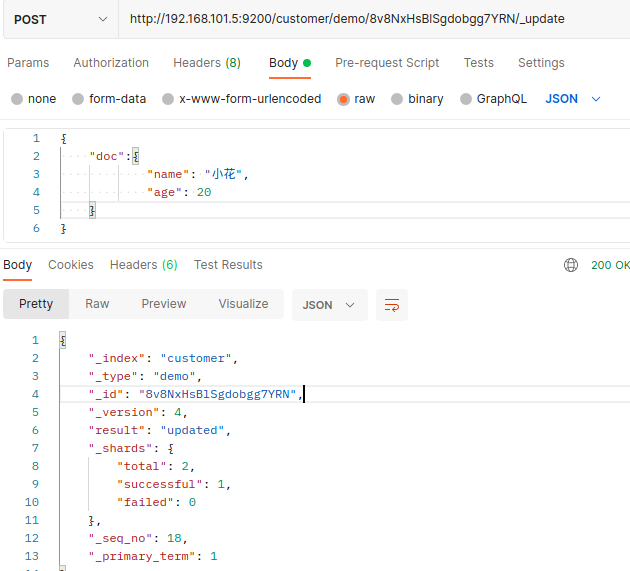
读取

更新2
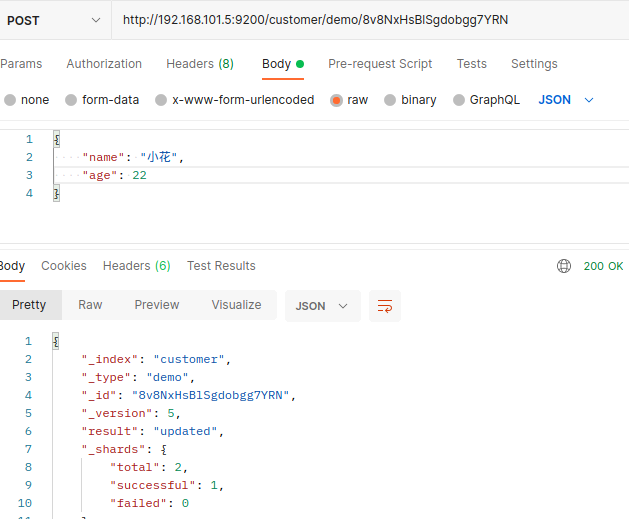
3.5 删除文档&索引
删除ID: http://192.168.100.5:9200/customer/demo/id/
{
"_index": "customer",
"_type": "demo",
"_id": "8v8NxHsBlSgdobgg7YRN",
"_version": 6,
"result": "deleted",
"_shards": {
"total": 2,
"successful": 1,
"failed": 0
},
"_seq_no": 20,
"_primary_term": 1
}
删除索引: http://192.168.100.5:9200/customer/
{
"acknowledged": true
}
查看索引: http://192.168.100.5:9200/_cat/indices
3.6 post bulk批量导入 API
使用postman请求
{"index":{"_id":"1"}}
{"name": "小霞"}
{"index":{"_id": "2"}}
{"name": "小花"}
post http://192.168.100.5:9200/customer/demo/_bulk
{
"took": 1,
"errors": false,
"items": [
{
"index": {
"_index": "customer",
"_type": "demo",
"_id": "1",
"_version": 2,
"result": "updated",
"_shards": {
"total": 2,
"successful": 1,
"failed": 0
},
"_seq_no": 1,
"_primary_term": 1,
"status": 200
}
},
{
"index": {
"_index": "customer",
"_type": "demo",
"_id": "2",
"_version": 1,
"result": "created",
"_shards": {
"total": 2,
"successful": 1,
"failed": 0
},
"_seq_no": 2,
"_primary_term": 1,
"status": 201
}
}
]
}
http://192.168.100.5:9200/customer/demo/1
可视化操作

POST /_bulk
{
"delete": {
"_index": "website",
"_type": "blog",
"_id": "123"
},
"create": {
"_index": "website",
"_type": "blog",
"_id": "123"
},
"title": "My first blog post",
"index": { "_index": "website", "_type": "blog"},
"title": "My second blog post",
"update": { "_index": "website", "_type": "blog", "_id": "123"},
"doc": {"title": "My updated blog post"}
}
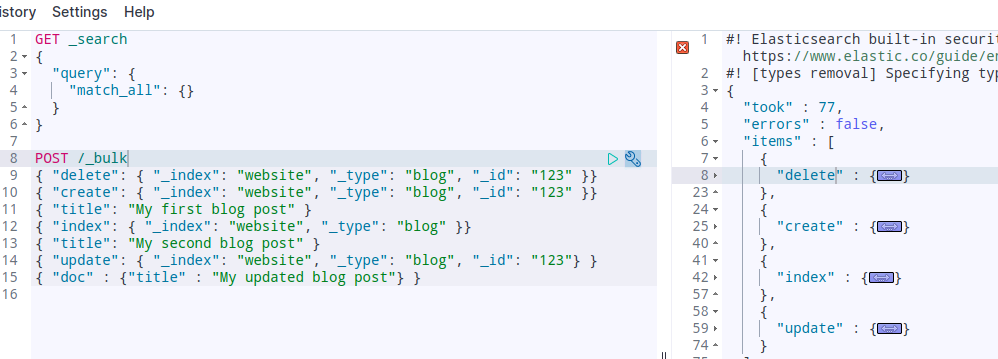
样本测试数据

4 映射配置(_mapping)
索引有了,接下来肯定是添加数据。但是,在添加数据之前必须定义映射。
什么是映射?
映射是定义文档的过程,文档包含哪些字段,这些字段是否保存,是否索引,是否分词等
只有配置清楚,Elasticsearch才会帮我们进行索引库的创建(不一定)
4.1 PUT 创建映射字段
PUT /索引库名/_mapping/类型名称
{
"properties": {
"字段名": {
"type": "类型",
"index": true,
"store": true,
"analyzer": "分词器"
}
}
}
类型名称:就是前面将的type的概念,类似于数据库中的不同表
字段名:类似于列名,properties下可以指定许多字段。
每个字段可以有很多属性。例如:
- type:类型,可以是text、long、short、date、integer、object等
- index:是否索引,默认为true
- store:是否存储,默认为false
- analyzer:分词器,这里使用ik分词器:
ik_max_word或者ik_smart
示例
发起请求:
示例1
PUT atguigu/_mapping/goods
{
"properties": {
"title": {
"type": "text",
"analyzer": "ik_max_word"
},
"images": {
"type": "keyword",
"index": "false"
},
"price": {
"type": "long"
}
}
}
示例2
PUT /my_index
{
"mappings": {
"properties": {
"age":{"type":"integer"},
"email":{"type":"keyword"},
"name":{"type":"text"}
}
}
}
响应结果:
{
"acknowledged": true
}

4.2 GET 查看映射关系
语法:
GET /索引库名/_mapping
示例:
GET /atguigu/_mapping
响应:
{
"atguigu" : {
"mappings" : {
"goods" : {
"properties" : {
"images" : {
"type" : "keyword",
"index" : false
},
"price" : {
"type" : "long"
},
"title" : {
"type" : "text",
"analyzer" : "ik_max_word"
}
}
}
}
}
}
type:字段类型。String(text keyword) Numeric(long integer float double) date boolean
index:是否创建索引
analyzer:分词器(ik_max_word)
4.3 PUT 添加索引字段
PUT /my_index/_mapping
{
"properties": {
"employee-id":{ #字段
"type":"keyword", #类型
"index":false #可检索
}
}
}
对于已经存在的映射字段,我们不能更新。更新必须创建新的索引进行数据迁移
4.4 映射 PUT 数据迁移
_type="account" 变为>_type: "_doc",,取消了type,6.0之后取消了type
GET /bank/_mapping
PUT /newbank
{
"mappings": {
"properties": {
"account_number": {
"type": "long"
},
"address": {
"type": "text"
},
"age": {
"type": "integer"
},
"balance": {
"type": "integer"
},
"city": {
"type": "keyword"
},
"email": {
"type": "keyword"
},
"employer": {
"type": "keyword"
},
"firstname": {
"type": "text"
},
"gender": {
"type": "keyword"
},
"lastname": {
"type": "text"
},
"state": {
"type": "keyword"
}
}
}
}
GET /newbank
POST _reindex
{
"source":{
"index":"bank",
"type":"account"
},
"dest":{
"index":"newbank"
}
}
GET /newbank/_search #_type="account" 变为> _type: "_doc",,取消了type,6.0之后取消了type
5 新增文档(document)
有了索引、类型和映射,就可以对文档做增删改查操作了。
5.1 基本玩法
如果我们想要自己新增的时候指定id,可以这么做:
POST /索引库名/类型/id值
{
...
}
演示:
查询得到两条数据:小米手机的id是我们指定的id
_source:源文档信息,所有的数据都在里面。_id:这条文档的唯一标示,与文档自己的id字段没有关联
5.2 智能判断
事实上Elasticsearch非常智能,你不需要给索引库设置任何mapping映射,它也可以根据你输入的数据来判断类型,动态添加数据映射。
测试一下:
POST /atguigu/goods/2
{
"title":"小米手机",
"images":"http://image.jd.com/12479122.jpg",
"price":2899,
"stock": 200,
"saleable":true,
"attr": {
"category": "手机",
"brand": "小米"
}
}
我们额外添加了stock库存,saleable是否上架,attr其他属性几个字段。
来看结果:GET /atguigu/_search
GET /atguigu/_search
{
"took" : 7,
"timed_out" : false,
"_shards" : {
"total" : 2,
"successful" : 2,
"skipped" : 0,
"failed" : 0
},
"hits" : {
"total" : 2,
"max_score" : 1.0,
"hits" : [
{
"_index" : "atguigu",
"_type" : "goods",
"_id" : "1",
"_score" : 1.0,
"_source" : {
"title" : "华为手机",
"images" : "http://image.jd.com/12479122.jpg",
"price" : 4288
}
},
{
"_index" : "atguigu",
"_type" : "goods",
"_id" : "2",
"_score" : 1.0,
"_source" : {
"title" : "小米手机",
"images" : "http://image.jd.com/12479122.jpg",
"price" : 2899,
"stock" : 200,
"saleable" : true,
"attr" : {
"category" : "手机",
"brand" : "小米"
}
}
}
]
}
}
再看下索引库的映射关系: GET /atguigu/_mapping
{
"atguigu" : {
"mappings" : {
"goods" : {
"properties" : {
"attr" : {
"properties" : {
"brand" : {
"type" : "text",
"fields" : {
"keyword" : {
"type" : "keyword",
"ignore_above" : 256
}
}
},
"category" : {
"type" : "text",
"fields" : {
"keyword" : {
"type" : "keyword",
"ignore_above" : 256
}
}
}
}
},
"images" : {
"type" : "keyword",
"index" : false
},
"price" : {
"type" : "long"
},
"saleable" : {
"type" : "boolean"
},
"stock" : {
"type" : "long"
},
"title" : {
"type" : "text",
"analyzer" : "ik_max_word"
}
}
}
}
}
}
stock,saleable,attr都被成功映射了。
如果是字符串类型的数据,会添加两种类型:text + keyword。如上例中的category 和 brand
6 删除数据
删除使用DELETE请求,同样,需要根据id进行删除:
语法
DELETE /索引库名/类型名/id值
示例:
DELETE /atguigu/goods/3
结果:
{
"_index" : "atguigu",
"_type" : "goods",
"_id" : "3",
"_version" : 2,
"result" : "deleted",
"_shards" : {
"total" : 4,
"successful" : 1,
"failed" : 0
},
"_seq_no" : 1,
"_primary_term" : 1
}
7 分词
7.1 默认分词器,对中文不友好
POST _analyze
{
"analyzer": "standard",
"text": "Bucket aggregations don’t calculate metrics over fields like"
}
结果:
{
"tokens" : [
{
"token" : "bucket",
"start_offset" : 0,
"end_offset" : 6,
"type" : "<ALPHANUM>",
"position" : 0
},
{
"token" : "aggregations",
"start_offset" : 7,
"end_offset" : 19,
"type" : "<ALPHANUM>",
"position" : 1
},
--------------------
POST _analyze
{
"analyzer": "standard",
"text": "我爱你java"
}
结果:
{
"tokens" : [
{
"token" : "学",
"start_offset" : 0,
"end_offset" : 1,
"type" : "<IDEOGRAPHIC>",
"position" : 0
},
{
"token" : "校",
"start_offset" : 1,
"end_offset" : 2,
"type" : "<IDEOGRAPHIC>",
"position" : 1
},
{
"token" : "我",
"start_offset" : 2,
"end_offset" : 3,
"type" : "<IDEOGRAPHIC>",
"position" : 2
},
7.2 ik 分词器
解压到es:plugins
重启es
# 分词失败
POST _analyze
{
"analyzer": "standard",
"text": "我爱你中国"
}
# 分词ok
POST _analyze
{
"analyzer": "ik_smart",
"text": "我爱你中国"
}
# 多词组合【如下图】
POST _analyze
{
"analyzer": "ik_max_word",
"text": "我爱你中国"
}
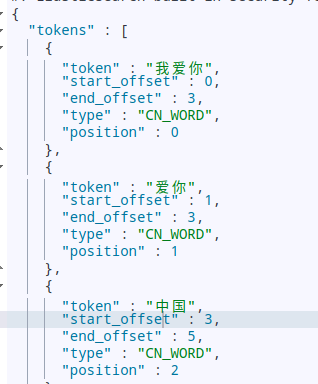
7.3 自定义分词
nginx 配置
http://localhost:50005/es/fenci.txt
ik/config/IKAnalyzer.cfg.xml:
<entry key="remote_ext_dict">http://localhost:50005/es/fenci.txt</entry>
重启es
8 查询
8.1 2种查询
| took | Elasticsearch执行搜索的时间(毫秒) |
|---|---|
| time_out | 告诉我们搜索是否超时 |
| _shards | 告诉我们多少个分片被搜索了,以及统计了成功/失败的搜索分片 |
| hits | 搜索结果 |
| hits.total | 搜索结果 |
| hits.hits | 实际的搜索结果数组(默认为前10的文档) |
| sort | 结果的排序key (键) (没有则按score排序) |
| score和max_score | 相关性得分和最高分 |
GET bank/_search?q=*&sort=account_number:asc
GET bank/_search
{
"query":{
"match_all": {}
},
"sort": [
{
"account_number": "asc"
},
{
"balance": "desc"
}
]
}
查询所有:
GET /{index}/_search
根据id查询:
GET /{index}/{type}/{id}
除了上述简单查询之外。elasticsearch作为搜索引擎,最复杂最强大的功能就是搜索查询功能。包括:匹配查询、词条查询、模糊查询、组合查询、范围查询、高亮、排序、分页等等查询功能。
基本查询语法如下:
GET /索引库名/_search
{
"query":{
"查询类型":{
"查询条件":"查询条件值"
}
}
}
这里的query代表一个查询对象,里面可以有不同的查询属性
- 查询类型:
- 例如:
match_all,match,term,range等等
- 例如:
- 查询条件:查询条件会根据类型的不同,写法也有差异,后面详细讲解
查询结果:
- took:查询花费时间,单位是毫秒
- time_out:是否超时
- _shards:分片信息
- hits:搜索结果总览对象
- total:搜索到的总条数
- max_score:所有结果中文档得分的最高分
- hits:搜索结果的文档对象数组,每个元素是一条搜索到的文档信息
- _index:索引库
- _type:文档类型
- _id:文档id
- _score:文档得分
- _source:文档的源数据
8.2 数据准备
POST /atguigu/goods/_bulk
{"index":{"_id":1}}
{ "title":"小米手机", "images":"http://image.jd.com/12479122.jpg", "price":1999, "stock": 200, "attr": { "category": "手机", "brand": "小米" } }
{"index":{"_id":2}}
{"title":"超米手机", "images":"http://image.jd.com/12479122.jpg", "price":2999, "stock": 300, "attr": { "category": "手机", "brand": "小米" } }
{"index":{"_id":3}}
{ "title":"小米电视", "images":"http://image.jd.com/12479122.jpg", "price":3999, "stock": 400, "attr": { "category": "电视", "brand": "小米" } }
{"index":{"_id":4}}
{ "title":"小米笔记本", "images":"http://image.jd.com/12479122.jpg", "price":4999, "stock": 200, "attr": { "category": "笔记本", "brand": "小米" } }
{"index":{"_id":5}}
{ "title":"华为手机", "images":"http://image.jd.com/12479122.jpg", "price":3999, "stock": 400, "attr": { "category": "手机", "brand": "华为" } }
{"index":{"_id":6}}
{ "title":"华为笔记本", "images":"http://image.jd.com/12479122.jpg", "price":5999, "stock": 200, "attr": { "category": "笔记本", "brand": "华为" } }
{"index":{"_id":7}}
{ "title":"荣耀手机", "images":"http://image.jd.com/12479122.jpg", "price":2999, "stock": 300, "attr": { "category": "手机", "brand": "华为" } }
{"index":{"_id":8}}
{ "title":"oppo手机", "images":"http://image.jd.com/12479122.jpg", "price":2799, "stock": 400, "attr": { "category": "手机", "brand": "oppo" } }
{"index":{"_id":9}}
{ "title":"vivo手机", "images":"http://image.jd.com/12479122.jpg", "price":2699, "stock": 300, "attr": { "category": "手机", "brand": "vivo" } }
{"index":{"_id":10}}
{ "title":"华为nova手机", "images":"http://image.jd.com/12479122.jpg", "price":2999, "stock": 300, "attr": { "category": "手机", "brand": "华为" } }
对非文本数据检索用 trem,对文本|全文检索就用 match
8.3 匹配查询(match && match_all)
8.3.1 查询所有(match_all )
GET /atguigu/_search
{
"query":{ #查询规则
"match_all": {} #查询所有
},
"from": 0, #开始位置
"size": 4, #选取条数
"sort": [ #排序
{
"balance":{ #处理的字段
"order": "desc" # 排序规则
}
}
],
"_source": ["balance","lastname"] #显示字段
}
query:代表查询对象match_all:代表查询所有
8.3.2 条件匹配(match )
GET /atguigu/_search
{
"query": {
"match": {
"title": "小米手机"
}
}
}
查询出很多数据,不仅包括小米手机,而且与小米或者手机相关的都会查询到,说明多个词之间是or的关系。
某些情况下,我们需要更精确查找,我们希望这个关系变成and,可以这样做:
GET /atguigu/_search
{
"query": {
"match": {
"title": {
"query": "小米手机",
"operator": "and"
}
}
}
}
查询结果:
{
"took" : 26,
"timed_out" : false,
"_shards" : {
"total" : 2,
"successful" : 2,
"skipped" : 0,
"failed" : 0
},
"hits" : {
"total" : 1,
"max_score" : 1.7037868,
"hits" : [
{
"_index" : "atguigu",
"_type" : "goods",
"_id" : "1",
"_score" : 1.7037868,
"_source" : {
"title" : "小米手机",
"images" : "http://image.jd.com/12479122.jpg",
"price" : 1999,
"stock" : 200,
"attr" : {
"category" : "手机",
"brand" : "小米"
}
}
}
]
}
}
8.3.3 短语匹配 (match phrase)
GET bank/_search
{
"query": {
"match_phrase": {
"address": "mill lane"
}
}
}
只会包含 address=mill lane 记录
8.3.4 子属性匹配(字段.xx)
GET /atguigu/_search
{
"query": {
"match": {
"attr.brand": "小米"
}
}
}
8.3.5 多字段匹配(multi_match)
match只能根据一个字段匹配查询,如果要根据多个字段匹配查询可以使用multi_match
GET /atguigu/_search
{
"query":{
"multi_match": {
"query": "小米",
"fields": ["title", "attr.brand.keyword"]
}
}
}
GET /atguigu/_search
{
"query": {
"multi_match": {
"query": "mill",
"fields": ["address","city"]
}
}
}
fields值匹配到query
8.4 词条查询,精确值匹配(term)
term 查询被用于精确值 匹配,这些精确值可能是数字、时间、布尔或者那些未分词的字符串。
GET /atguigu/_search
{
"query":{
"term":{
"price": 4999
}
}
}
# 对非文本数据检索用trem,对文本|全文检索就用match
GET bank/_search
{
"query": {
"term": {
"age": "28"
}
}
}
GET bank/_search
{
"query": {
"term": {
"address": "mill" ########会取不到数据
}
}
}
GET bank/_search
{
"query": {
"match": {
"address": "990 mill"
}
}
}
GET bank/_search
{
"query": {
"match": {
"address.keyword": "990 mill" # 精确匹配
}
}
}
GET bank/_search
{
"query": {
"match_phrase": {
"address": "990 mill"
}
}
}
8.5 范围查询(range)
range 查询找出那些落在指定区间内的数字或者时间
GET /atguigu/_search
{
"query":{
"range": {
"price": {
"gte": 1000,
"lt": 3000
}
}
}
}
range查询允许以下字符:gt、gte、lt、lte
| 操作符 | 说明 |
|---|---|
| gt | 大于 |
| gte | 大于等于 |
| lt | 小于 |
| lte | 小于等于 |
8.6 布尔组合(bool)
布尔查询又叫 组合查询、复合查询
bool把各种其它查询通过must(与)、must_not(非)、should(或)的方式进行组合
GET /atguigu/_search
{
"query":{
"bool":{
"must": [
{
"range": {
"price": {
"gte": 1000,
"lte": 3000
}
}
},
{
"range": {
"price": {
"gte": 2000,
"lte": 4000
}
}
}
]
}
}
}
GET bank/_search
{
"query": {
"bool": {
"must": [
{
"match": {
"gender": "F"
}
},
{
"match": {
"address": "Mill"
}
}
]
}
}
}
查询gender=M并且address=Mill
GET bank/_search
{
"query": {
"bool": {
"must": [ #必须是什么
{
"match": {
"gender": "M"
}
},
{
"match": {
"address": "Mill"
}
}
],
"must_not": [ #必须不是什么
{
"match": {
"age": 38
}
}
],
"should": [ #应该,能匹配到最好,没匹配到也不伤大雅,满足的话max_score会更高
{
"match": {
"lastname": "Wallace"
}
}
]
}
}
}
查询gender=F & address=Mill & age!=38 ,lastname能匹配到最好,没匹配到也不伤大雅
注意:一个组合查询里面只能出现一种组合,不能混用
8.7 过滤(filter)
所有的查询都会影响到文档的评分及排名。如果我们需要在查询结果中进行过滤,并且不希望过滤条件影响评分,那么就不要把过滤条件作为查询条件来用。而是使用filter方式:
GET /atguigu/_search
{
"query": {
"bool": {
"must": {
"match": { "title": "小米手机" }
},
"filter": {
"range": {
"price": { "gt": 2000, "lt": 3000 }
}
}
}
}
}
# filter不会计算相关性得分_score,must反之
GET bank/_search
{
"query": {
"bool": {
"must": [
{
"range": {
"age": {
"gte": 18,
"lte": 30
}
}
}
]
}
}
}
--------------
GET bank/_search
{
"query": {
"bool": {
"filter": {
"range": {
"age": {
"gte": 18,
"lte": 30
}
}
}
}
}
}
# filter 最好是放在最后过滤,这样不会影响查询条件和相关性得分
GET bank/_search
{
"query": {
"bool": {
"must": [
{
"match": {
"gender": "M"
}
},
{
"match": {
"address": "Mill"
}
}
],
"must_not": [
{
"match": {
"age": 18
}
}
],
"should": [
{
"match": {
"lastname": "Holland"
}
}
],
"filter": {
"range": {
"age": {
"gte": 18,
"lte": 30
}
}
}
}
}
}
注意:filter 最好是放在最后过滤,这样不会影响查询条件和相关性得分。filter中还可以再次进行bool组合条件过滤。
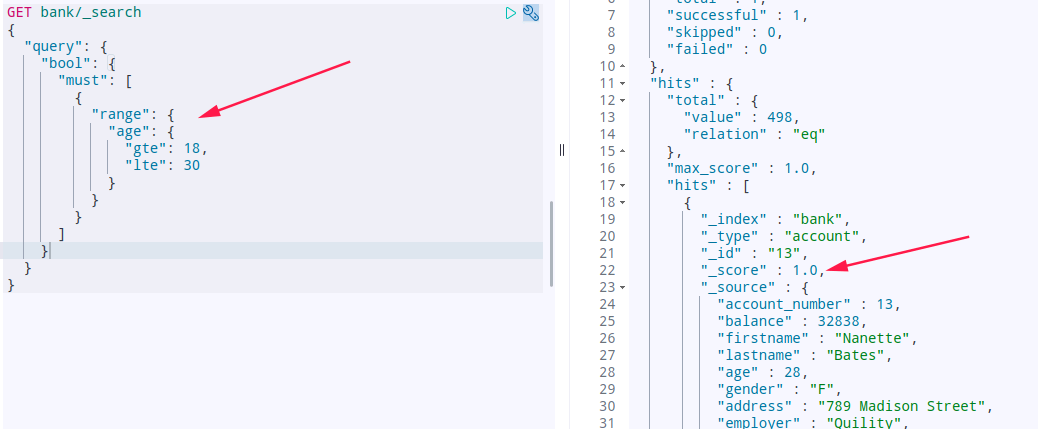
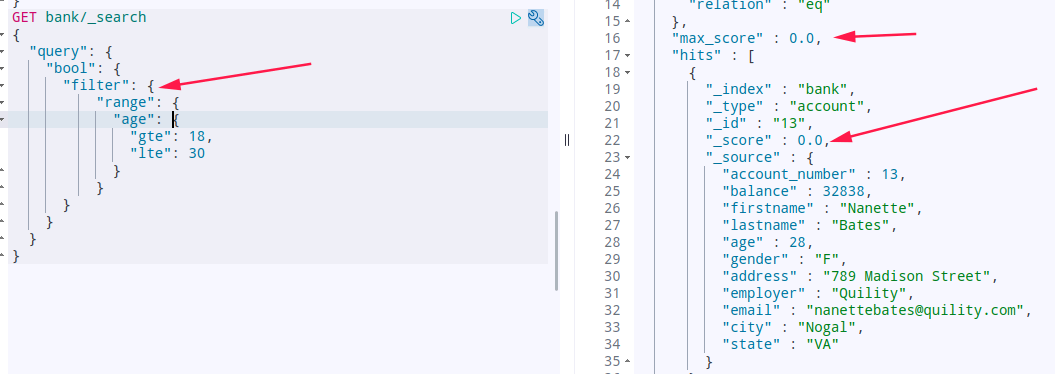
8.8 排序(sort)
sort 可以让我们按照不同的字段进行排序,并且通过order指定排序的方式
GET /atguigu/_search
{
"query": {
"match": {
"title": "小米手机"
}
},
"sort": [
{
"price": { "order": "desc" }
},
{
"_score": { "order": "desc"}
}
]
}
8.9 分页(from/size)
GET /atguigu/_search
{
"query": {
"match": {
"title": "小米手机"
}
},
"from": 2,
"size": 2
}
from:从那一条开始
size:取多少条
8.10 高亮(highlight)
发现:高亮的本质是给关键字添加了 <em> 标签,在前端再给该标签添加样式即可。
GET /atguigu/_search
{
"query": {
"match": {
"title": "小米"
}
},
"highlight": {
"fields": {"title": {}},
"pre_tags": "<em>",
"post_tags": "</em>"
}
}
fields:高亮字段
pre_tags:前置标签
post_tags:后置标签
查询结果如下:
8.11 结果过滤(_source)
默认情况下,elasticsearch在搜索的结果中,会把文档中保存在_source的所有字段都返回。
如果我们只想获取其中的部分字段,可以添加_source的过滤
GET /atguigu/_search
{
"_source": ["title","price"],
"query": {
"term": {
"price": 2699
}
}
}
返回结果,只有两个字段:
{
"took" : 9,
"timed_out" : false,
"_shards" : {
"total" : 2,
"successful" : 2,
"skipped" : 0,
"failed" : 0
},
"hits" : {
"total" : 1,
"max_score" : 1.0,
"hits" : [
{
"_index" : "atguigu",
"_type" : "goods",
"_id" : "9",
"_score" : 1.0,
"_source" : {
"price" : 2699,
"title" : "vivo手机"
}
}
]
}
}
9 聚合(aggregations)
搜索address中包含mill的所有人的年龄分布以及平均年龄,但不显示这些人的详情
GET bank/_search
{
"query": {
"match": {
"address": "mill"
}
},
"aggs": {
"ageAgg": {
"terms": {
"field": "age",
"size": 10
}
},
"ageAvg": {
"avg": {
"field": "age"
}
},
"balanceAvg": {
"avg": {
"field": "balance"
}
}
},
"size": 0
}
按照年龄聚合,并且请求这些年龄段的这些人的平均薪资
GET bank/_search
{
"query": {
"match_all": {}
},
"aggs": {
"ageAgg": {
"terms": {
"field": "age",
"size": 100
},
"aggs": {
"ageAvg": {
"avg": {
"field": "balance"
}
}
}
}
},
"size": 0
}
查出所有年龄分布,并且这些年隆段中M的平均薪资和F的平均薪资以及这个年龄段的总体平均薪资
GET bank/_search
{
"query": {
"match_all": {}
},
"aggs": {
"ageAgg": {
"terms": {
"field": "age",
"size": 100
},
"aggs": {
"genderAgg": {
"terms": {
"field": "gender.keyword",
"size": 10
},
"aggs": {
"balanceAvg": {
"avg": {
"field": "balance"
}
}
}
},
"ageAvg": {
"avg": {
"field": "balance"
}
}
}
}
},
"size": 1
}
聚合可以让我们极其方便的实现对数据的统计、分析。例如:
- 什么品牌的手机最受欢迎?
- 这些手机的平均价格、最高价格、最低价格?
- 这些手机每月的销售情况如何?
实现这些统计功能的比数据库的sql要方便的多,而且查询速度非常快,可以实现实时搜索效果。
9.1 基本概念
Elasticsearch中的聚合,包含多种类型,最常用的两种,一个叫桶,一个叫度量:
桶(bucket)
桶的作用,是按照某种方式对数据进行分组,每一组数据在ES中称为一个桶,例如我们根据国籍对人划分,可以得到中国桶、英国桶,日本桶
或者我们按照年龄段对人进行划分:0~10,10~20,20~30,30~40等。
Elasticsearch中提供的划分桶的方式有很多:
- Date Histogram Aggregation:根据日期阶梯分组,例如给定阶梯为周,会自动每周分为一组
- Histogram Aggregation:根据数值阶梯分组,与日期类似
- Terms Aggregation:根据词条内容分组,词条内容完全匹配的为一组
- Range Aggregation:数值和日期的范围分组,指定开始和结束,然后按段分组
bucket aggregations 只负责对数据进行分组,并不进行计算,因此往往bucket中往往会嵌套另一种聚合:metrics aggregations即度量
度量(metrics)
分组完成以后,我们一般会对组中的数据进行聚合运算,例如求平均值、最大、最小、求和等,这些在ES中称为度量
比较常用的一些度量聚合方式:
- Avg Aggregation:求平均值
- Max Aggregation:求最大值
- Min Aggregation:求最小值
- Percentiles Aggregation:求百分比
- Stats Aggregation:同时返回avg、max、min、sum、count等
- Sum Aggregation:求和
- Top hits Aggregation:求前几
- Value Count Aggregation:求总数
9.2 聚合为桶
首先,我们按照手机的品牌attr.brand.keyword来划分桶
GET /atguigu/_search
{
"size" : 0,
"aggs" : {
"brands" : {
"terms" : {
"field" : "attr.brand.keyword"
}
}
}
}
- size: 查询条数,这里设置为0,因为我们不关心搜索到的数据,只关心聚合结果,提高效率
- aggs:声明这是一个聚合查询,是aggregations的缩写
- brands:给这次聚合起一个名字,任意。
- terms:划分桶的方式,这里是根据词条划分
- field:划分桶的字段
- terms:划分桶的方式,这里是根据词条划分
- brands:给这次聚合起一个名字,任意。
结果:
{
"took" : 124,
"timed_out" : false,
"_shards" : {
"total" : 2,
"successful" : 2,
"skipped" : 0,
"failed" : 0
},
"hits" : {
"total" : 10,
"max_score" : 0.0,
"hits" : [ ]
},
"aggregations" : {
"brands" : {
"doc_count_error_upper_bound" : 0,
"sum_other_doc_count" : 0,
"buckets" : [
{
"key" : "华为",
"doc_count" : 4
},
{
"key" : "小米",
"doc_count" : 4
},
{
"key" : "oppo",
"doc_count" : 1
},
{
"key" : "vivo",
"doc_count" : 1
}
]
}
}
}
- hits:查询结果为空,因为我们设置了size为0
- aggregations:聚合的结果
- brands:我们定义的聚合名称
- buckets:查找到的桶,每个不同的品牌字段值都会形成一个桶
- key:这个桶对应的品牌字段的值
- doc_count:这个桶中的文档数量
9.3 桶内度量
前面的例子告诉我们每个桶里面的文档数量,这很有用。 但通常,我们的应用需要提供更复杂的文档度量。 例如,每种品牌手机的平均价格是多少?
因此,我们需要告诉Elasticsearch使用哪个字段,使用何种度量方式进行运算,这些信息要嵌套在桶内,度量的运算会基于桶内的文档进行
现在,我们为刚刚的聚合结果添加 求价格平均值的度量:
GET /atguigu/_search
{
"size" : 0,
"aggs" : {
"brands" : {
"terms" : {
"field" : "attr.brand.keyword"
},
"aggs":{
"avg_price": {
"avg": {
"field": "price"
}
}
}
}
}
}
- aggs:我们在上一个aggs(brands)中添加新的aggs。可见
度量也是一个聚合 - avg_price:聚合的名称
- avg:度量的类型,这里是求平均值
- field:度量运算的字段
结果:
{
"took" : 41,
"timed_out" : false,
"_shards" : {
"total" : 2,
"successful" : 2,
"skipped" : 0,
"failed" : 0
},
"hits" : {
"total" : 10,
"max_score" : 0.0,
"hits" : [ ]
},
"aggregations" : {
"brands" : {
"doc_count_error_upper_bound" : 0,
"sum_other_doc_count" : 0,
"buckets" : [
{
"key" : "华为",
"doc_count" : 4,
"avg_price" : {
"value" : 3999.0
}
},
{
"key" : "小米",
"doc_count" : 4,
"avg_price" : {
"value" : 3499.0
}
},
{
"key" : "oppo",
"doc_count" : 1,
"avg_price" : {
"value" : 2799.0
}
},
{
"key" : "vivo",
"doc_count" : 1,
"avg_price" : {
"value" : 2699.0
}
}
]
}
}
}
可以看到每个桶中都有自己的avg_price字段,这是度量聚合的结果
9.4 桶内嵌套桶
刚刚的案例中,我们在桶内嵌套度量运算。事实上桶不仅可以嵌套运算, 还可以再嵌套其它桶。也就是说在每个分组中,再分更多组。
比如:我们想统计每个品牌都生产了那些产品,按照attr.category.keyword字段再进行分桶
GET /atguigu/_search
{
"size" : 0,
"aggs" : {
"brands" : {
"terms" : {
"field" : "attr.brand.keyword"
},
"aggs":{
"avg_price": {
"avg": {
"field": "price"
}
},
"categorys": {
"terms": {
"field": "attr.category.keyword"
}
}
}
}
}
}
部分结果:
{
"took" : 19,
"timed_out" : false,
"_shards" : {
"total" : 2,
"successful" : 2,
"skipped" : 0,
"failed" : 0
},
"hits" : {
"total" : 10,
"max_score" : 0.0,
"hits" : [ ]
},
"aggregations" : {
"brands" : {
"doc_count_error_upper_bound" : 0,
"sum_other_doc_count" : 0,
"buckets" : [
{
"key" : "华为",
"doc_count" : 4,
"categorys" : {
"doc_count_error_upper_bound" : 0,
"sum_other_doc_count" : 0,
"buckets" : [
{
"key" : "手机",
"doc_count" : 3
},
{
"key" : "笔记本",
"doc_count" : 1
}
]
},
"avg_price" : {
"value" : 3999.0
}
},
{
"key" : "小米",
"doc_count" : 4,
"categorys" : {
"doc_count_error_upper_bound" : 0,
"sum_other_doc_count" : 0,
"buckets" : [
{
"key" : "手机",
"doc_count" : 2
},
{
"key" : "电视",
"doc_count" : 1
},
{
"key" : "笔记本",
"doc_count" : 1
}
]
},
"avg_price" : {
"value" : 3499.0
}
},
{
"key" : "oppo",
"doc_count" : 1,
"categorys" : {
"doc_count_error_upper_bound" : 0,
"sum_other_doc_count" : 0,
"buckets" : [
{
"key" : "手机",
"doc_count" : 1
}
]
},
"avg_price" : {
"value" : 2799.0
}
},
{
"key" : "vivo",
"doc_count" : 1,
"categorys" : {
"doc_count_error_upper_bound" : 0,
"sum_other_doc_count" : 0,
"buckets" : [
{
"key" : "手机",
"doc_count" : 1
}
]
},
"avg_price" : {
"value" : 2699.0
}
}
]
}
}
}
- 我们可以看到,新的聚合
categorys被嵌套在原来每一个brands的桶中。 - 每个品牌下面都根据
attr.category.keyword字段进行了分组 - 我们能读取到的信息:
- 华为有4中产品
- 华为产品的平均售价是 3999.0美元。
- 其中3种手机产品,1种笔记本产品
10 SpringData-Elasticsearch
10.1 介绍
目前市面上有两类客户端
一类是TransportClient 为代表的ES原生客户端,不能执行原生dsl语句必须使用它的Java api方法。
另外一种是以Rest Api为主的missing client,最典型的就是jest。 这种客户端可以直接使用dsl语句拼成的字符串,直接传给服务端,然后返回json字符串再解析。
两种方式各有优劣,但是最近elasticsearch官网,宣布计划在7.0以后的版本中废除TransportClient。以RestClient为主。
由于原生的Elasticsearch客户端API非常麻烦。所以这里直接学习Spring提供的套件:Spring Data Elasticsearch。
spring-data-Elasticsearch 使用之前,必须先确定版本,elasticsearch 对版本的要求比较高。
java-API选择:https://www.elastic.co/guide/en/elasticsearch/client/index.html
选择:Java REST Client 7.14] => JavaHighLevelRESTClient 文档
10.2 创建springboot 项目
创建单独项目 yumall-search
<properties>
<elasticsearch.version>7.14.0</elasticsearch.version>
</properties>
<dependency>
<groupId>org.elasticsearch.client</groupId>
<artifactId>elasticsearch-rest-high-level-client</artifactId>
<version>7.14.0</version>
</dependency>
<dependency>
<groupId>org.springframework.boot</groupId>
<artifactId>spring-boot-starter-data-elasticsearch</artifactId>
<exclusions>
<exclusion>
<groupId>org.elasticsearch.client</groupId>
<artifactId>elasticsearch-rest-high-level-client</artifactId>
</exclusion>
<exclusion>
<groupId>org.elasticsearch.client</groupId>
<artifactId>transport</artifactId>
</exclusion>
</exclusions>
</dependency>
<dependency>
<groupId>org.elasticsearch.client</groupId>
<artifactId>elasticsearch-rest-high-level-client</artifactId>
<version>6.8.1</version>
</dependency>
<dependency>
<groupId>org.elasticsearch.client</groupId>
<artifactId>transport</artifactId>
<version>6.8.1</version>
</dependency>
加入nacos、common、@EnableDiscoveryClient
#开启服务发现
spring:
cloud:
nacos:
discovery:
server-addr: 127.0.0.1:8848
10.3 ban测试
创建配置类
// RestClient builder = RestClient.builder(new HttpHost("192.168.100.5", 9200, "http"));
// new RestHighLevelClient(builder);
测试
public class Demo {
@Autowired
private RestHighLevelClient client;
@Test
public void getClientBan() {
System.out.println(client);//null
}
}
///Junit4 测试类加上注解,在运行:org.elasticsearch.client.RestHighLevelClient@6f6f65a4
@RunWith(SpringRunner.class)
@SpringBootTest
public class DemoTesst{}
10.4 测试保存
@SpringBootTest
public class DemoTest {
@Test
public void indexData() throws IOException {
IndexRequest indexRequest = new IndexRequest("users");
indexRequest.id("1");
// indexRequest.source("name","xiaoyu","age","19");
User user = new User();
user.setName("小华");
user.setGender("男");
user.setAge(20);
String jsonString = JSON.toJSONString(user);
indexRequest.source(jsonString, XContentType.JSON);//要保存的数据json
//开始保存
IndexResponse indexResponse = client.index(indexRequest, ElasticSearchConfig.COMMON_OPTIONS);
System.out.println("indexResponse = " + indexResponse);
}
}
10.5 测试检索
结构
//1、创建检索请求 SearchRequest > sourceBuilder[添加聚合?] > searchRequest.source(sourceBuilder);
//2、执行结果 SearchResponse=client.search(searchRequest,自定义OPTIONS);
//3、分析结果 searchResponse:getHits获取数据,getAggregations获取聚合
实例
public class Demo {
public void serachData() throws IOException {
//1、创建检索请求
SearchRequest searchRequest = new SearchRequest();
//指定索引
searchRequest.indices("bank");
//指定DSL,检索条件
//SearchSourceBuilder sourceBuilde 封装的条件
SearchSourceBuilder sourceBuilder = new SearchSourceBuilder();
//1.1)、构造检索条件
//sourceBuilder.query();
//sourceBuilder.from();
//sourceBuilder.size();
//sourceBuilder.aggregatipn()
sourceBuilder.query(QueryBuilders.matchQuery("address", "mill"));
//1.2)、按照年龄的值分布进行聚合
TermsAggregationBuilder ageAgg = AggregationBuilders.terms("ageAgg").field("age").size(100);
sourceBuilder.aggregation(ageAgg);
//1.3)、平均薪资
AvgAggregationBuilder balanceAvg = AggregationBuilders.avg("balanceAvg").field("balance");
sourceBuilder.aggregation(balanceAvg);
System.out.println("检索条件:" + sourceBuilder.toString());
//要检索内容
searchRequest.source(sourceBuilder);
//2、执行结果 SearchResponse
SearchResponse searchResponse = client.search(searchRequest, ElasticSearchConfig.COMMON_OPTIONS);
//3、分析结果
// System.out.println("检索结果:" + searchResponse.toString());
// Map map = JSON.parseObject(searchResponse.toString(), Map.class);
//3.1)、获取所有数据;
SearchHits hits = searchResponse.getHits();
SearchHit[] searchHits = hits.getHits();
for (SearchHit hit : searchHits) {
/*
"_index":"bank",
"_type":"account",
"_id":"970",
"_score":5.4032025,
"_source":{数据
*/
// hit.getIndex();hit.getType();hit.getId();
String string = hit.getSourceAsString();
Account account = JSON.parseObject(string, Account.class);
System.out.println("account = " + account);
}
//3.2)、获取这次检索到的分析信息;
Aggregations aggregations = searchResponse.getAggregations();
for (Aggregation aggregation : aggregations.asList()) {
System.out.println("当前聚合" + aggregation.getName());
}
Terms ageAgg1 = aggregations.get("ageAgg");
for (Terms.Bucket bucket : ageAgg1.getBuckets()) {
String keyAsString = bucket.getKeyAsString();
System.out.println("年龄: " + keyAsString + "==>" + bucket.getDocCount());
}
}
}

10.6 创建module
在application.properties中添加配置
spring.elasticsearch.rest.uris=http://172.16.116.100:9200
# 集群情况下
spring.elasticsearch.rest.uris[0]=http://172.16.116.100:9200
spring.elasticsearch.rest.uris[1]=http://172.16.116.100:9200
10.7 实体类
@Data
@AllArgsConstructor
@NoArgsConstructor
@Document(indexName = "user", type = "info", shards = 3, replicas = 2)
public class User {
@Id
private Long id;
@Field(type = FieldType.Text, analyzer = "ik_max_word")
private String name;
@Field(type = FieldType.Integer)
private Integer age;
@Field(type = FieldType.Keyword)
private String password;
}
Spring Data通过注解来声明字段的映射属性,有下面的三个注解:
@Document作用在类,标记实体类为文档对象,一般有四个属性- indexName:对应索引库名称
- type:对应在索引库中的类型
- shards:分片数量,默认5
- replicas:副本数量,默认1
@Id作用在成员变量,标记一个字段作为id主键@Field作用在成员变量,标记为文档的字段,并指定字段映射属性:- type:字段类型,取值是枚举:FieldType
- index:是否索引,布尔类型,默认是true
- store:是否存储,布尔类型,默认是false
- analyzer:分词器名称:ik_max_word
10.8 创建索引及映射
@SpringBootTest
class EsDemoApplicationTests {
// ElasticsearchTemplate 是 TransportClient 客户端
// ElasticsearchRestTemplate 是 RestHighLevel 客户端
@Autowired
ElasticsearchRestTemplate restTemplate;
@Test
void contextLoads() {
// 创建索引
this.restTemplate.createIndex(User.class);
// 创建映射
this.restTemplate.putMapping(User.class);
// 删除索引
// this.restTemplate.deleteIndex("user");
}
}
10.9 Repository文档操作
Spring Data 的强大之处,就在于你不用写任何DAO处理,自动根据方法名或类的信息进行CRUD操作。只要你定义一个接口,然后继承Repository提供的一些子接口,就能具备各种基本的CRUD功能。
其中ElasticsearchRepository接口功能最强大。该接口的方法包括:
10.9.1 新增
public class Demo {
@Autowired
UserRepository userRepository;
@Test
void testAdd() {
this.userRepository.save(new User(1l, "zhang3", 20, "123456"));
}
}
修改和新增是同一个接口,区分的依据就是id,这一点跟我们在页面发起PUT请求是类似的。
10.9.2 删除
public class Demo {
@Test
void testDelete() {
this.userRepository.deleteById(1l);
}
}
10.10 查询
10.10.1 基本查询
查询一个:
public class Demo {
@Test
void testFind() {
System.out.println(this.userRepository.findById(1l).get());
}
}
10.10.2 条件查询
Spring Data 的另一个强大功能,是根据方法名称自动实现功能。
比如:你的方法名叫做:findByTitle,那么它就知道你是根据title查询,然后自动帮你完成,无需写实现类。
当然,方法名称要符合一定的约定:
| Keyword | Sample | Elasticsearch Query String |
|---|---|---|
And | findByNameAndPrice | {"bool" : {"must" : [ {"field" : {"name" : "?"}}, {"field" : {"price" : "?"}} ]}} |
Or | findByNameOrPrice | {"bool" : {"should" : [ {"field" : {"name" : "?"}}, {"field" : {"price" : "?"}} ]}} |
Is | findByName | {"bool" : {"must" : {"field" : {"name" : "?"}}}} |
Not | findByNameNot | {"bool" : {"must_not" : {"field" : {"name" : "?"}}}} |
Between | findByPriceBetween | {"bool" : {"must" : {"range" : {"price" : {"from" : ?,"to" : ?,"include_lower" : true,"include_upper" : true}}}}} |
LessThanEqual | findByPriceLessThan | {"bool" : {"must" : {"range" : {"price" : {"from" : null,"to" : ?,"include_lower" : true,"include_upper" : true}}}}} |
GreaterThanEqual | findByPriceGreaterThan | {"bool" : {"must" : {"range" : {"price" : {"from" : ?,"to" : null,"include_lower" : true,"include_upper" : true}}}}} |
Before | findByPriceBefore | {"bool" : {"must" : {"range" : {"price" : {"from" : null,"to" : ?,"include_lower" : true,"include_upper" : true}}}}} |
After | findByPriceAfter | {"bool" : {"must" : {"range" : {"price" : {"from" : ?,"to" : null,"include_lower" : true,"include_upper" : true}}}}} |
Like | findByNameLike | {"bool" : {"must" : {"field" : {"name" : {"query" : "?*","analyze_wildcard" : true}}}}} |
StartingWith | findByNameStartingWith | {"bool" : {"must" : {"field" : {"name" : {"query" : "?*","analyze_wildcard" : true}}}}} |
EndingWith | findByNameEndingWith | {"bool" : {"must" : {"field" : {"name" : {"query" : "*?","analyze_wildcard" : true}}}}} |
Contains/Containing | findByNameContaining | {"bool" : {"must" : {"field" : {"name" : {"query" : "**?**","analyze_wildcard" : true}}}}} |
In | findByNameIn(Collection<String>names) | {"bool" : {"must" : {"bool" : {"should" : [ {"field" : {"name" : "?"}}, {"field" : {"name" : "?"}} ]}}}} |
NotIn | findByNameNotIn(Collection<String>names) | {"bool" : {"must_not" : {"bool" : {"should" : {"field" : {"name" : "?"}}}}}} |
Near | findByStoreNear | Not Supported Yet ! |
True | findByAvailableTrue | {"bool" : {"must" : {"field" : {"available" : true}}}} |
False | findByAvailableFalse | {"bool" : {"must" : {"field" : {"available" : false}}}} |
OrderBy | findByAvailableTrueOrderByNameDesc | {"sort" : [{ "name" : {"order" : "desc"} }],"bool" : {"must" : {"field" : {"available" : true}}}} |
准备一组数据:
public class Demo {
@Test
void testAddAll() {
List<User> users = new ArrayList<>();
users.add(new User(1l, "柳岩", 18, "123456"));
users.add(new User(2l, "范冰冰", 19, "123456"));
users.add(new User(3l, "李冰冰", 20, "123456"));
users.add(new User(4l, "锋哥", 21, "123456"));
users.add(new User(5l, "小鹿", 22, "123456"));
users.add(new User(6l, "韩红", 23, "123456"));
this.userRepository.saveAll(users);
}
}
在UserRepository中定义一个方法:
第一种写法:
public interface UserRepository extends ElasticsearchRepository<User, Long> {
/**
* 根据年龄区间查询
* @param age1
* @param age2
* @return
*/
List<User> findByAgeBetween(Integer age1, Integer age2);
}
测试:
public class Demo {
@Test
void testFindByAgeBetween() {
System.out.println(this.userRepository.findByAgeBetween(20, 30));
}
}
第二种写法:
public interface Demo {
@Query("{\n" +
" \"range\": {\n" +
" \"age\": {\n" +
" \"gte\": \"?0\",\n" +
" \"lte\": \"?1\"\n" +
" }\n" +
" }\n" +
" }")
List<User> findByQuery(Integer age1, Integer age2);
}
测试:
public class Demo {
@Test
void testFindByQuery() {
System.out.println(this.userRepository.findByQuery(20, 30));
}
}
10.10.3 自定义查询
public class Demo {
@Test
public void testNative() {
// 初始化自定义查询对象
NativeSearchQueryBuilder queryBuilder = new NativeSearchQueryBuilder();
// 构建查询
queryBuilder.withQuery(QueryBuilders.matchQuery("name", "冰冰"));
// 排序
queryBuilder.withSort(SortBuilders.fieldSort("age").order(SortOrder.ASC));
// 分页
queryBuilder.withPageable(PageRequest.of(0, 2));
// 高亮
queryBuilder.withHighlightBuilder(new HighlightBuilder().field("name").preTags("<em>").postTags("</em>"));
// 执行查询,获取分页结果集
Page<User> userPage = this.userRepository.search(queryBuilder.build());
// 总页数
System.out.println(userPage.getTotalPages());
// 总记录数
System.out.println(userPage.getTotalElements());
// 当前页数据
System.out.println(userPage.getContent());
}
}
NativeSearchQueryBuilder:Spring提供的一个查询条件构建器,帮助构建json格式的请求体
Page<item>:默认是分页查询,因此返回的是一个分页的结果对象,包含属性:
- totalElements:总条数
- totalPages:总页数
- Iterator:迭代器,本身实现了Iterator接口,因此可直接迭代得到当前页的数据
